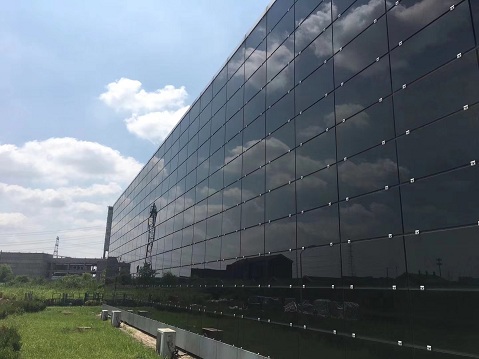- This topic is empty.
-
AuthorPosts
-
2025-11-24 at 1:40 pm #86894
In the push for sustainable urban development, facade solar panels have emerged as an innovative solution for integrating renewable energy into high-rise buildings. Unlike traditional rooftop solar panels, which occupy limited roof space, facade solar panels are installed on the exterior walls of buildings, harnessing vertical surfaces for energy generation. This approach not only increases the potential area for solar energy capture but also contributes to the aesthetic appeal of modern architecture. However, the deployment of facade solar panels in high-rise structures comes with unique challenges that require careful planning, technological innovation, and regulatory compliance. This article explores these challenges and offers practical solutions for architects, engineers, and developers.
Understanding Facade Solar Panels
Facade solar panels, also known as building-integrated photovoltaics (BIPV), serve a dual function: they act as both an architectural element and a renewable energy source. These panels can be designed as glass panels, metal cladding, or flexible thin-film sheets that seamlessly integrate with the building envelope. For high-rise buildings, facade solar panels provide an opportunity to maximize energy generation without occupying ground space—a critical consideration in densely populated urban areas.
The vertical installation of solar panels on facades allows high-rise buildings to contribute significantly to their own energy needs, potentially reducing reliance on grid electricity and lowering overall carbon emissions. Furthermore, facade solar panels can enhance the building's visual identity, creating dynamic, energy-conscious designs that appeal to environmentally aware tenants and stakeholders.
Challenges of Installing Facade Solar Panels on High-Rise Buildings
While the benefits of facade solar panels are clear, installing them on high-rise buildings presents several technical, financial, and regulatory challenges:
1. Wind Load and Structural Safety
High-rise buildings are exposed to strong wind forces, which can impact the stability of facade solar panels. Unlike roof-mounted panels, vertical panels face lateral wind pressure that can stress mounting systems and the building’s exterior. If not properly designed, these loads may cause panel detachment, structural damage, or even pose safety risks to pedestrians below.
2. Limited Sunlight Exposure
Facade solar panels on tall buildings may receive uneven sunlight throughout the day due to shading from adjacent buildings, overhangs, and architectural features. North-facing or shadowed walls may generate insufficient energy, affecting overall system efficiency. Moreover, the angle of incidence of sunlight on vertical surfaces is less optimal compared to inclined rooftop panels, leading to lower energy output per square meter.
3. Maintenance and Cleaning Difficulties
Maintaining solar panels on high-rise facades is considerably more challenging than rooftop systems. Dust, dirt, bird droppings, and air pollution can accumulate on panels, reducing their efficiency. Cleaning vertical panels at great heights requires specialized equipment, safety measures, and increased operational costs.

4. Installation Complexity
Facade solar panels often need to be customized to fit building dimensions, window layouts, and design specifications. The installation process is more complex than typical rooftop systems, requiring precise engineering, specialized scaffolding, and coordination with other building trades. Additionally, integrating electrical wiring, inverters, and energy storage systems into the vertical facade without compromising aesthetics adds another layer of complexity.
5. Cost Considerations
The cost of facade solar panels tends to be higher than conventional rooftop systems. Custom design, high-quality materials, and labor-intensive installation contribute to increased upfront investment. Financial feasibility is often a key consideration for developers, especially when calculating the payback period and return on investment.
6. Regulatory and Compliance Issues
High-rise buildings must comply with local building codes, fire safety regulations, and zoning restrictions. Installing facade solar panels may require additional permits or adherence to specific facade materials and fire-resistance ratings. Navigating these regulatory requirements can slow down project timelines and add legal complexity.
Solutions and Best Practices for High-Rise Facade Solar Panels
Despite these challenges, several technological innovations and best practices can facilitate successful deployment of facade solar panels on high-rise buildings:
1. Advanced Mounting Systems
To withstand high wind loads, engineers can use reinforced mounting brackets, tensioned cables, and aerodynamic panel designs that reduce wind pressure. Structural analysis during the design phase ensures that panels are securely anchored without compromising the building envelope. Using lightweight yet strong materials such as aluminum frames or tempered glass reduces stress on the facade.
2. Optimized Panel Orientation and Tracking
High-rise buildings can optimize energy generation by carefully selecting panel orientation and considering shading patterns. East- and west-facing facades can be used to capture morning and afternoon sunlight, while south-facing panels maximize midday exposure in the northern hemisphere. Some modern facade solar panels incorporate dynamic tracking systems that adjust panel angles throughout the day, increasing energy output even on vertical surfaces.
3. Self-Cleaning and Durable Materials
To minimize maintenance challenges, developers can choose solar panels with hydrophobic coatings or self-cleaning surfaces. These technologies reduce dust accumulation and water spotting, maintaining efficiency over time. Additionally, selecting corrosion-resistant and UV-stable materials ensures durability in urban environments with pollution and harsh weather.
4. Modular and Prefabricated Designs
Using modular, prefabricated panels simplifies installation on high-rise buildings. Prefabrication allows panels to be manufactured with precise dimensions and integrated mounting systems, reducing on-site labor and installation time. Modular designs also facilitate easy replacement or maintenance of individual panels without affecting the entire facade.
5. Integrated Energy Storage Solutions
Combining facade solar panels with battery storage systems enables high-rise buildings to store excess energy generated during peak sunlight hours. This approach ensures a stable energy supply, reduces reliance on the grid, and maximizes the return on investment. Advanced energy management software can further optimize energy usage and distribution across building systems.
6. Compliance and Consultation with Authorities
Early engagement with local building authorities and adherence to fire safety and structural codes is critical. Consulting with architects, structural engineers, and solar energy specialists ensures that facade solar panel installations meet all regulatory requirements. This proactive approach helps avoid costly redesigns or delays during construction.
7. Innovative Financing and Incentive Programs
High upfront costs can be mitigated through green building incentives, tax credits, and renewable energy grants offered by governments and utilities. Developers can also explore power purchase agreements (PPAs) or energy-as-a-service models, where third-party providers install and maintain the solar panels, reducing initial capital expenditure.
Case Studies: Successful High-Rise Facade Solar Projects
Several cities around the world have successfully implemented facade solar panels on high-rise buildings:
-
Bahrain World Trade Center: Features integrated wind turbines and solar panels on facades, demonstrating the potential for vertical renewable energy in urban settings.
-
Pearl River Tower, Guangzhou: Utilizes facade solar panels along with double-skin facades for energy efficiency and aesthetic appeal.
-
One Central Park, Sydney: Incorporates vertical gardens and solar panels on high-rise facades, combining sustainability with innovative design.
These projects illustrate that with proper planning and technology, facade solar panels can significantly contribute to the energy efficiency of high-rise buildings while enhancing architectural value.
Conclusion
Facade solar panels represent a transformative solution for high-rise buildings seeking to integrate renewable energy into urban environments. While challenges such as wind loads, limited sunlight, maintenance difficulties, and regulatory compliance exist, advancements in materials, engineering, and energy management provide effective solutions. By adopting best practices—such as advanced mounting systems, self-cleaning panels, optimized orientation, and integrated energy storage—developers can overcome these obstacles and harness the full potential of vertical solar energy.
For architects, engineers, and building owners, the successful implementation of facade solar panels requires a balance between aesthetics, performance, and sustainability. As urban centers continue to grow and the demand for renewable energy increases, facade solar panels are poised to play an increasingly vital role in shaping the cities of the future
http://www.fgnexsolar.com
fgnexsolar -
-
AuthorPosts
- You must be logged in to reply to this topic.


